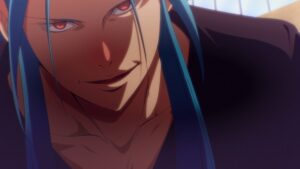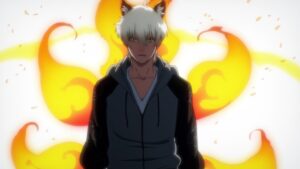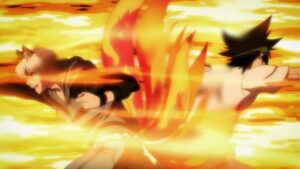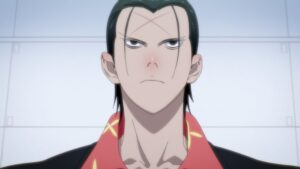These two episodes delivered exactly what I wanted from The God of High School at this late stage: nonstop action between ultra-powerful fighters. They also abandoned all pretense of caring about story or characterization, which isn’t a bad thing – the cast’s believability has been on the skid since late July, and the plot hasn’t fared much better. Now that celestial combat techniques and carnivorous tentacle monsters are the show’s main concerns, it’s free to blow itself up in the season finale, and I won’t feel obligated to watch a potential sequel. Plus, we’ll get some nonsensical, animator-driven action along the way, as we did this week. Many shounen fans will have bailed on GOH by this point due to its lack of cohesion, but I’m still here, and vaguely looking forward to the conclusion. If you’re with me, hit the jump and witness my futile attempt at parsing its most recent pair of episodes.
After a brief absence from the story, Park Ilpyo returned to prominence during this doubleheader. He received a Daewi-ish ‘help the sick’ motive for competing in the tournament, then got the jump on Mori during their semifinal match, listing his opponent’s weaknesses mid-fight to create a blueprint for his own defeat. Of course, Ilpyo was never going to win this particular battle, since his other reason for participating in the tournament was to provide guidance to Mori, thus fulfilling his childhood promise to Taejin. Mori did plenty to ensure his own victory, including the incorporation of his teammates’ techniques into his repertoire (which struck me as an unlikely move for such an airheaded character). Once the fight entered a higher dimension, though, my questioning of the protagonist’s powers of mimicry faded away. Ilpyo was possessed by a nine-tailed fox spirit, and Mori followed suit by summoning a giant tornado and slamming his opponent to the mat by controlling a giant god hand… or something.
I don’t claim to have all – or any – of the answers here, but since multiple characters referred to Ilpyo as “the key” during his transformation, whatever entity Mori controlled during their fight probably has the opposite alignment. We know from previous episodes that Nox wants to destroy “the key” and maintain their god’s supremacy; thus, the striped arm wearing the beaded bracelet that appeared during Mori’s finishing scene likely belongs to an opposing god. How is he able to influence or synchronize with such a powerful being? It probably has to do with his lineage, since he’s the grandson of one of the world’s greatest fighters, but apart from that, your guess is as good as mine. The insertion of gods and keys into a once-humble martial arts anime has never made much sense, but it’s not as though they tried and failed to rationalize it. This series just doesn’t care to explain itself where its supernatural elements are concerned, and the price of entry is your acceptance of that fact.
Speaking of not explaining yourself, what was the deal with the massive battle that took place outside the GOH stadium during episode 10? (This happened before Ilpyo entered nine-tails mode, and ran in parallel to the hand-to-hand portion of his semifinal bout.) There were so many parties involved that it felt like a premature series finale. The GOH and Nox bosses’ remote struggle over that massive airborne sword was probably the most significant event, since it coincided with the appearance of Nox’s god. The object of their worship was portrayed only as a massive shadowy figure, kept in check by a weapons expert named Seo Hallyang. His barrage of portal-enhanced missiles, gunfire, arrows and energy beams was backed by a team of drummers, whose percussive motions received quite a bit of attention during the drawing process. On the ground below, the GOH judges sliced through wave after wave of Nox grunts using their charyeok abilities. All told, the show rotated between four sets of characters in a bonkers final battle – except there was nothing final about it.
Were I in the mood to break down God of High School’s narrative failures, I’d weigh the components of this massive clash against each other based on our preparedness for them. Some we’d seen before, while others came from whatever’s left of left field. But frankly, the show pushed through the scene with such speed that its place in the story hardly matters. By the end of episode 11, GOH was already gearing up for another seismic conflict, with an army of hellish angels descending from a doorway in the clouds (the same doorway from which Nox’s god emerged just hours beforehand). And that’s to say nothing of Jeon Jugok, the previously irrelevant character whose transformation into a man-eating monster was triggered by Ilpyo and Mori’s fight, then terminated upon his death minutes later. For such a horrifying scene, it smelled strongly of obligation, as though killing Jugok was the important part and all of his victims were merely collateral damage.
If you’re still reading, don’t take my acceptance of God of High School’s slapdash storytelling as a badge of approval. This show is pretty bad. It’s an interesting sort of badness, though – the kind that plays to the series’ strengths and ignores everything else, regardless of the fallout. Watching GOH feels like a gateway for newer fans to get into 80s OVAs, some of which are so light on exposition that you need to take notes to understand what the hell is going on. That kind of viewing experience is valuable in its own way, since it trains your brain to fill in the gaps without the yammering of a teenage protagonist’s inner monologue. And hey, GOH avoided the cardinal sin of Being Boring during these two episodes, which gives it a decent engagement average for the season. Given its most recent cliffhanger, I’m hoping the last two will be similarly entertaining. Even if they’re flops, though, I’ll be back in a couple weeks – same Star Crossed time, same Star Crossed channel.





Man this comment I saw on ANN explains all my thoughts and issues with this episode (and the series in general):
“I don’t get some of these adaptation changes. Mori defeating Il-Pyo is kind of bad, and unlike the webtoon there isn’t even the uncertainty whether or not Il-Pyo’s charyeok is the key. Nox’s goals are different here as well, but in a less comprehensive way (in the webtoon they serve all of the gods). In this episode alone, they’ve removed Mira’s best fight scene, had Mori leave the hospital ward before the Jugok attack and, for that matter, have kept Jugok’s transformation without any of the character or plot stuff around it. Like, why not just have Jugok be eaten in his initial fight with Jegal instead? Jegal was already heading to attack Il-Pyo in this episode, unlike in the webtoon, so Jugok was unneeded for pushing Jegal to accidentally hurt Il-Pyo’s friends. The anime could have given Jugok some more time, detailing his life and goals, as GoH did in the webtoon, making him a real character (if a basic one) and then just immediately have him be eaten by the shark. Also grieving the death of his last living relative would at give an explanation as to what Jugok’s grandfather is doing while the other members of the Six fight Nox.
The anime should have made improvements to the flow of the story so it could stand alone and not be dependent on the webtoon to give answers. The Webtoon outright explains what the key does in the next arc, why not move that explanation to this arc? The nature of gods, monsters and humans is also a plot element in a later arc, but the anime isn’t guaranteed later arcs – so just have Mujin explain it here. Charyeok was given to the humans by the gods to help them fight monsters, but this also created a taboo. The gods can no longer be hurt by humans due to a taboo, and so they exist above humanity. Nox serves the god’s will, Mujin and allies serve humanity, thus making them enemies to Nox. The key is a being whose hate of the gods facilitates breaking of the taboo. Mujin wants the key so he can fight the gods for humanity. That’s the context, just explain that to the audience. The anime instead suggests anything but. What the anime needs is context, not a fight scene with a character the viewer knows nothing about without reading the webtoon, that serves no purpose in this adaptation.
Beyond these adaptational issues, this episode shows there is also a problem with the overall anime’s direction – it just feels like a bunch of scenes stitched together without any narrative flow. Characters will move from location to location off-screen without really any acknowledgement in the prior scene that they were heading out, people who should be in a rush to get to the key don’t seem to be, and scenes with Nox and scenes with the tournament often feel unrelated. There is no effort to make stuff flow together.
Nobody should feel the need to read the webtoon if they don’t want to. You should never feel forced to watch or read anything that you don’t want to, be it by fans of the series or the anime itself. Media should be able to stand up on its own – the webtoon just works as a good comparison piece for the anime because the webtoon is telling the same basic story in a much better fashion. Both have good art as their selling point, just one doesn’t taint that by making it’s story such a confusing mess. At least until the Ragnarok arc, then the webtoon became a complete mess in desperate need for an ending that refuses to appear.”
Pretty ironic that they wrap up with “nobody should feel the need to read the webtoon if they don’t want to” after bitching about its superiority in several of the previous paragraphs.
ANN is run by a bunch of hypocrites and funimation sycophants. And Crunchy does not give a fuck about respecting the webtoon or presenting a well paced show. They just want to make something fast and furious because most people who will watch have short attention spans.